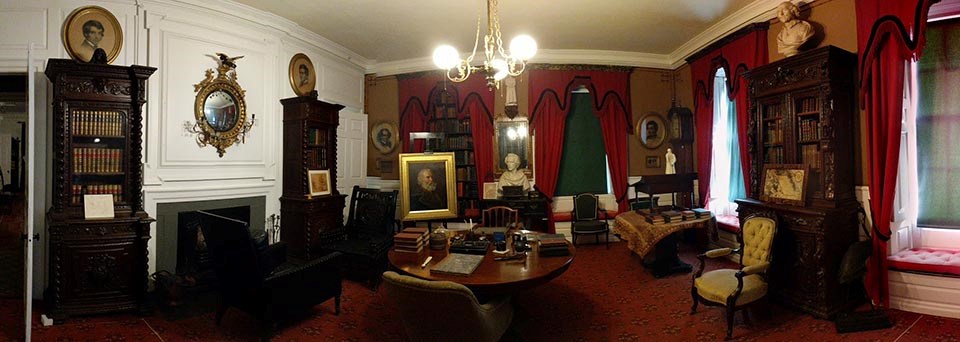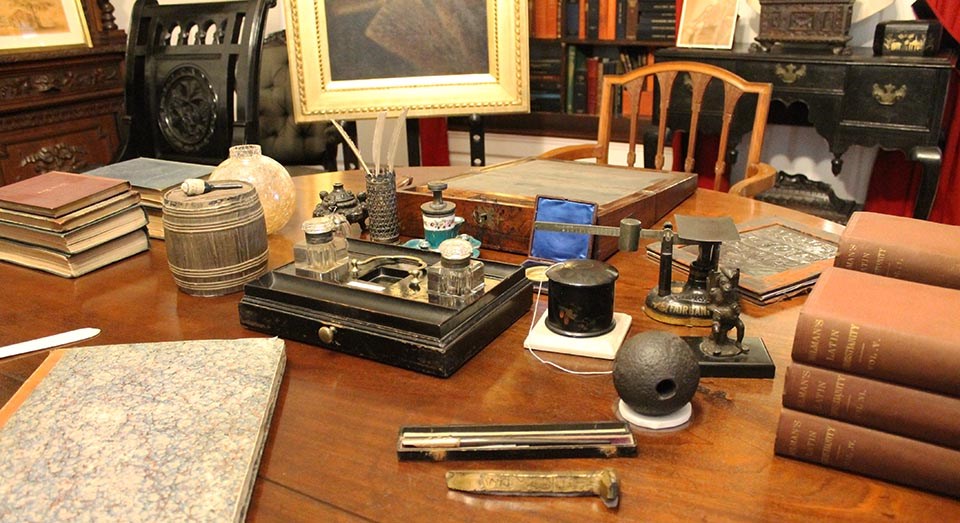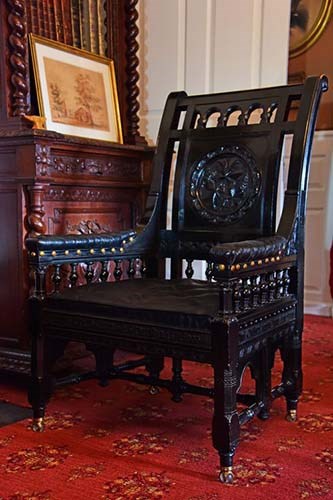
NPS Photo / Kate Hanson Plass The south- and east-facing room to the right of the front entry was used by George Washington as his dining room and meeting room, and later by Henry Longfellow as his study. It connects through two small passages to the library to the north. The majority of the woodwork dates to 1759, including the deep window seats and hinged shutters; the window sashes date to the 1790s. The original fireplace was wider than the one seen today. Longfellow installed the Gothic iron coal grate after 1847 and added the brown painted wallpaper with the faux bamboo molding in 1868. War RoomFrom July 1775 to April 1776 Washington held conferences and councils of war here with his generals: Israel Putnam, Artemas Ward, Charles Lee, Nathanael Greene, and others. In October 1775 a three-person committee from Congress in Philadelphia – Benjamin Franklin of Pennsylvania, Thomas Lynch of South Carolina, and Benjamin Harrison of Virginia – visited the site. The delegation spent a week in consultations with the commander-in- chief reviewing the issues facing the army and reinforced classical republican theories of civilian authority over the military. In this room, George Washington faced myriad unforeseen issues: adapting to a military culture and society very different from his own, conducting the Siege of Boston, addressing the presence of black soldiers in his army (something shocking to this Virginia slaveholder), etc. Much was accomplished here as a new army organization was crafted, Boston was evacuated with little bloodshed, and a new core of leadership emerged. George Washington himself grew as a leader, commander, politician, and a person as he became the face of the Revolutionary war effort. 
Buildings and Photograph Collection (3008-2-1-2) Poet's StudyFrom the mid-1840s until Henry W. Longfellow’s death in 1882, the room served as his study, a well-used place where he read, wrote poetry, correspondence, and journal entries, reviewed proofs, visited with family and friends, smoked cigars, played with his children, and took naps. During Fanny’s lifetime, although clearly Henry’s room, it was to a great degree her study and a family gathering room as well. He worked on most of his poems here, including "The Children's Hour" in which he describes how his three daughters, “grave Alice, and laughing Allegra, and Edith with golden hair,” would enter this room by the “three doors left unguarded” and climb over the arms and back of his chair. 
NPS Photo The round center table is covered in books, writing tools, and souvenirs. At center is a folding desk and quill pens belonging to the poet. Three inkwells sit next to the desk:

Buildings and Grounds Photograph Collection (3008-2-1-18) On a round table in the corner of the room by the window is a standing desk, at which Longfellow wrote by daylight and enjoyed a view across the meadows towards the Charles River. Perched on the ledge of the desk is a statue of Goethe acquired by Longfellow in Germany. 
© 2015 Xiomaro.com Next to the fireplace stands the armchair made from the “spreading chestnut tree” which Longfellow made famous in his poem "The Village Blacksmith." The chair is carved with horse-chestnut leaves and inscribed around the base with lines from the poem. The children of Cambridge presented the chair to Longfellow on his seventy-second birthday, February 27, 1879. To express his gratitude, Longfellow wrote his poem "From My Arm-Chair," exclaiming:
|
Last updated: February 2, 2022
